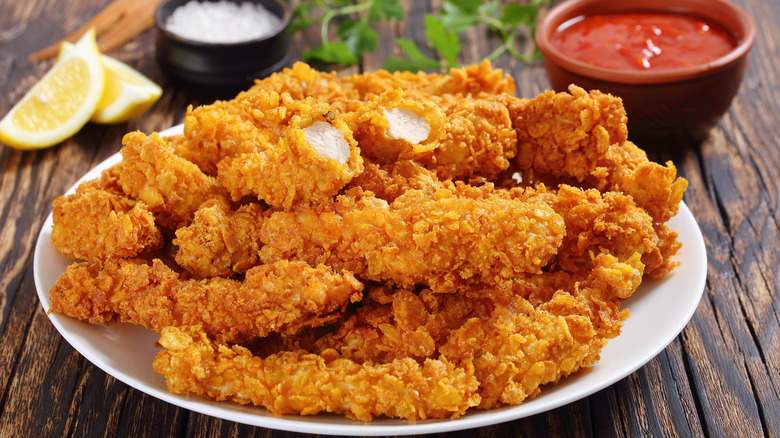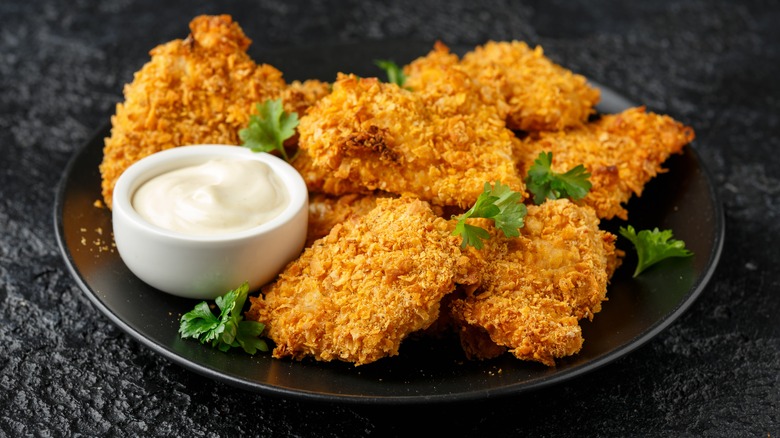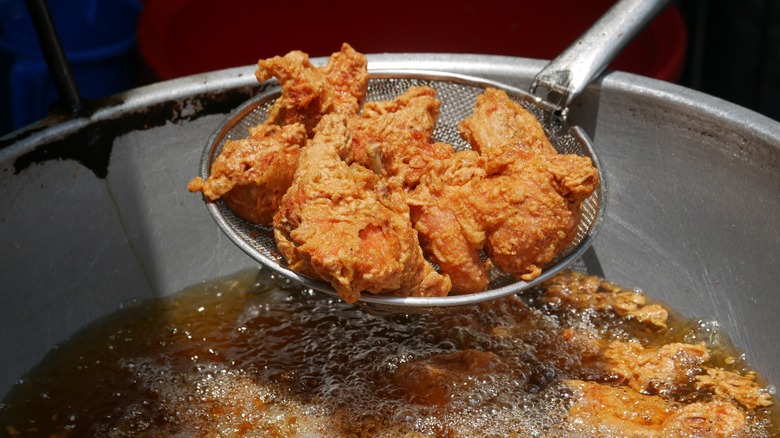Cereal Is The Coating Alternative That Adds Crunch To Chicken Tenders
Not all chicken tenders are created equal. For every fresh, hand-battered tender that's filled with juicy meat and a crunchy coating, there's a more drab option waiting in the freezer. One of the biggest ways to improve your tenders though is to get a shatteringly crisp breading. To do this, try ditching the breadcrumbs and turn to cereal.
Cereal tends to be brittle and crunchy, giving you a stronger coating option than breadcrumbs. Because of this, the tenders will also crisp up better in the oven. That's because the process of frying turns otherwise soft ingredients like flour into a crunchy exterior. So, without the hot oil, even a breadcrumb-coated tender won't crisp up as much. But, the already crunchy cereal will solve this problem. And, it gives you a pop of sweetness that plays well with the rich, fatty flavors of fried food.
To prepare your cereal coating, simply place a helping in a closed plastic bag and hit it with a rolling pin or pan to crush the flakes into smaller pieces. You're looking to create small pieces resembling panko breadcrumbs. Just don't over-pound the flakes into a fine powder, however, as you want some of those ultra crispy little pieces. Afterwards, dredge your chicken in flour, then eggs, and finally coat with the cereal. Dredging in eggs and flour first means that the breading will stick to the chicken properly, forming a uniform coating.
Choosing a cereal for your coating
There are many options to choose from when selecting a cereal for the chicken coating. Cornflakes are a common choice, because they have an ideally crispy texture to begin with and a relatively unobtrusive flavor profile. This allows the tasting notes of your chicken and spices to shine through. Cornflakes also have enough sugar to give the meal a little jolt, but not so much that the breading will burn easily.
If you're looking for a sweeter kind of fried chicken, try using a sugary cereal like Cap'n Crunch. This will give you a salty-sweet contrast, and will also fry up perfectly to a crisp. Just keep in mind that a higher sugar content means that the mixture will burn more rapidly — keep an eye on the tenders, and if they start to scorch you can finish them in the oven.
You can also make your tenders gluten-free by choosing the right cereal. Just be careful which brand you're selecting since some puffed rice cereals are gluten-free, but Rice Krispies for example are not because they contain malt flavoring. In this case, always check the ingredient list on the box to make sure you're working with a gluten-free alternative.
Seasoning tips and tricks for your chicken tenders
Using cereal for your chicken tender breading will give you plenty of flavor on its own, but you still need to season the poultry properly. Start by marinating or brining your chicken; since tenders are cut from underneath the breast, they're prone to drying out if not treated properly. Brining them in buttermilk will dramatically increase their flavor, and make them juicier, more tender, and harder to overcook. You can also use pickle brine to marinate the chicken, which will give you another pop of flavor.
Another good idea is to season the breading to amp up its flavor. Classic spices for fried chicken include smoked paprika, garlic powder, cayenne, and pepper. This is especially important for a cereal crust because of how sweet it is. If you're not counteracting that sweetness with savory spices, it can become overpowering.
When you're deep frying food at home, you need to carefully maintain your oil's temperature. If the oil gets too hot, the food will burn. If it cools down too much, your breading will get soggy and oily. To avoid this, don't crowd the pan with too many pieces of chicken. This will cause the temperature to plummet. Instead, fry in batches for the crispiest results.



